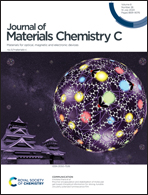The effect of single atom substitution (O, S or Se) on photocatalytic hydrogen evolution for triazine-based conjugated porous polymers†
Abstract
Conjugated porous polymers (CPPs) are an emerging class of promising photocatalysts due to their large specific surface areas and adjustable optical band gaps. We previously reported a novel CPP (P1) through linking donor–acceptor (D–A) type pyrazole–benzothiadiazole–pyrazole light-absorbing units through triazine units with promising photocatalytic hydrogen evolution behavior. The aim of this work was to investigate the effect of one-atom substitution (O, S, Se) on the optoelectronic properties and photocatalytic hydrogen evolution performance of CPPs. Two isostructural CPPs (P3, P4) that contain a one-atom substitution, O and Se, were designed and synthesized. Because of the variation of just a single atom, all the CPPs have similar pore structures, BET surface areas, and pore sizes. On the other hand, their optoelectronic properties are highly dependent on the choice of atom. However, their photocatalytic hydrogen evolution activities follow the trend of P1 > P3 > P4. Compared to P1 (S-containing), P3 (O-containing) has a lower hydrogen evolution rate (HER) of 22 μmol h−1 under visible light illumination (λ ≥ 420 nm) and an apparent quantum efficiency (AQE) of 1.43% at 420 ± 20 nm, due to its stronger acceptor 2,1,3-benzoxadiazole, broader optical band gap and more negative LUMO energy level; P4 has an even lower HER than P3, due to replacement with the heavy atom Se, which leads to a decrease in ionization, an increase in bond length and a decrease in acceptor aromaticity, a correspondingly weaker intramolecular charge transfer process, and a high electron–hole recombination rate. Therefore, the one-atom substitution (O, S, Se) strategy shows great importance in the design of D–A type organic porous conjugated polymers for photocatalytic hydrogen evolution.



 Please wait while we load your content...
Please wait while we load your content...